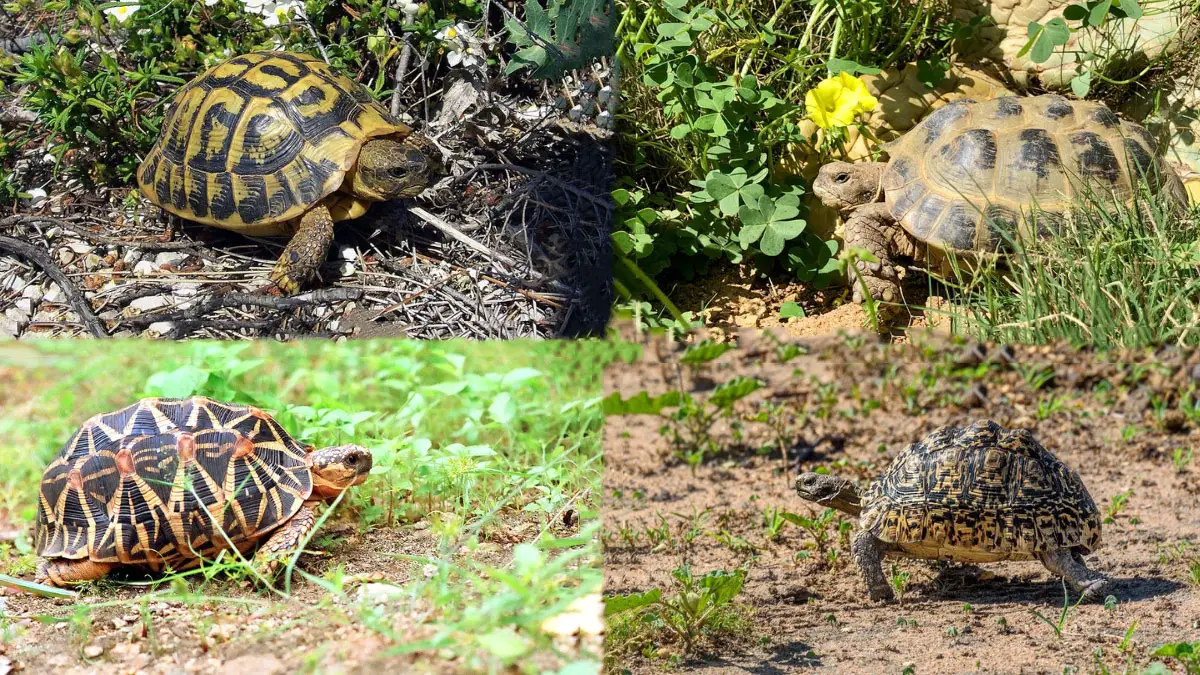7 Best Pet Tortoise Species for Beginners
Tortoises can be interesting companions to adults as pets. Some tortoise species are playful, and gentle and enjoy interacting with their owners. But there are many tortoise species, making it overwhelming to decide which one to adopt.
So, what are the best pet tortoise species for beginners? Some species, like Harmann, Russian, Leopard, Sulcata, etc., are easy to care for. But these tortoises grow to different sizes and weights and require individual care. Again, you must know the temperature they can handle and their diet habit to keep them healthy.
Read on to learn more about pet tortoise species with details before getting one of them as your pet friend.
1-Minute Overview
Contents
Before diving into the species’ details, take a quick look at these vital facts in the table below.
| Species Size | Species Name | Price (USD) | Weight (Kgs) | Length | Lifespan (Years) |
|---|---|---|---|---|---|
| Small Species | Hermann’s Tortoise | 150-500 | 3-4 | 5″-8″ | 60-70 |
| Indian Star Tortoise | 500-1500 | 1-2 | 6″-8″ | 60-80 | |
| Russian Tortoise | 100-200 | 1-2 | 8″-10″ | 40+ | |
| Medium Species | Yellow-Footed Tortoise | 250-700 | 11-15 | 15″-30″ | 50+ |
| Elongated Tortoise | 250-500 | 3-4 | 12″-14″ | 40-50 | |
| Leopard Tortoise | 350-500 | 18-20 | 10″-30″ | 100 | |
| Large Species | Sulcata Tortoise | 250-1500 | 31-45 | 24″-30″ | 70+ |
7 Best Pet Tortoise Species For Beginners to Raise at Home
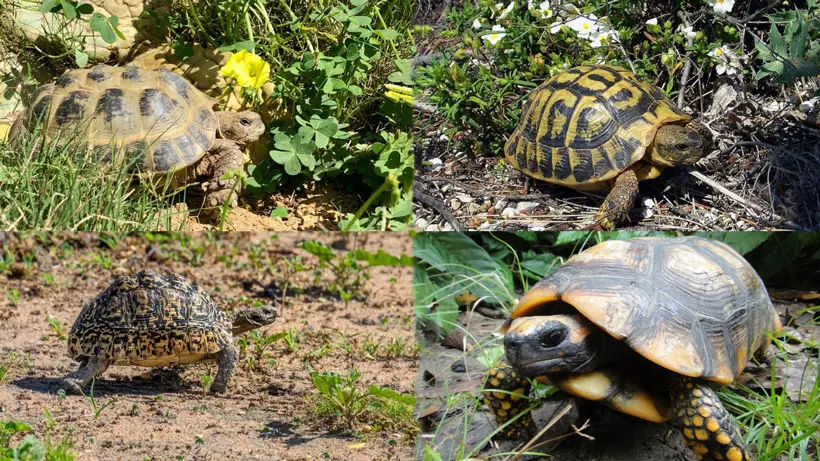
We have carefully selected a list of the best pet tortoise species ideal for home keeping. The list is divided into three segments based on the tortoise’s size. Details are given below:
Smallest Pet Tortoise Species
1. Hermann’s Tortoise (Testudo Hermani)
This popular tortoise species have attractive shell patterns and fun personalities. Hermann’s tortoise is the go-to option as the best tortoise for indoor pets.
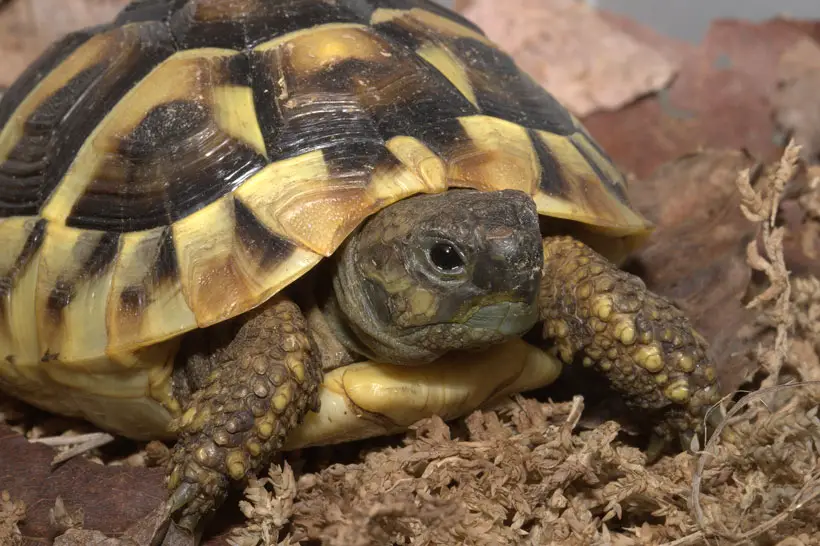
- Lifespan: These tortoises can live between 60 to 70 years. However, the record shows that a few of Hermann’s tortoises have lived up to 100 years.
- Whereabouts: You can find these tortoises in arid hillsides, dry meadows, rocky slopes, and the evergreen forest of the Mediterranean basin. It’s because Hermann’s tortoise prefers to live in shade rather than a moist environment.
- Species Size: Depending on the species’ varieties, they can grow in different lengths. Eastern male Hermanns grow up to 7″ and females 8″. In contrast, western male Hermanns grow up to 5″ and females 6″.
- Preferred Surroundings: If you want to pet Hermann’s tortoise, you need to ensure that their space is adequately arranged to resemble their natural environment. Place plants and rocks around their abode and create a space for them to hide.
- Required Temperature: Their basking space temperature should be 92°F and indoor space between 70°F-85°F. Hermann’s tortoises can withstand temperatures as low as 68°F at night. You also need to give them twelve hours of UVB light a day.
- Diet: Hermann’s tortoise loves leafy greens, kale, dandelions, and fruits as their food.
2. Indian Star (Geochelone Elegans)
Another smart and adorable small pet tortoise is the Indian Star. These tortoises are popular for their star-shaped shells and can adapt to the environment quickly. Here are more details:
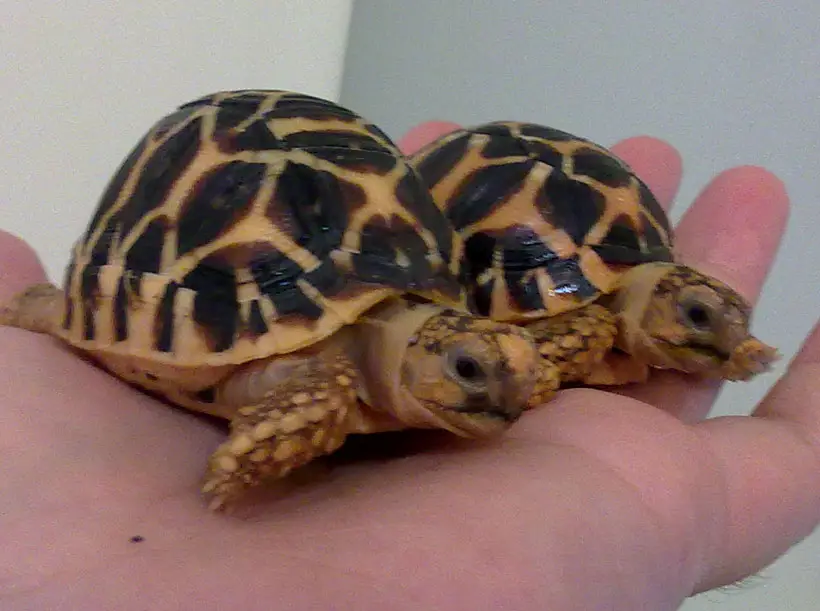
- Nature: Indian Star tortoises are gentle and calm. They can mix well with similar species. However, they’re shy; hence, you should feed and handle them with care.
- Lifespan: They can live for 60 to 80 years in captivity.
- Whereabouts: Indian Stars are native tortoises of India, Pakistan, and Sri Lanka. They prefer living in brush forests and arid climates.
- Species Size: Depending on their climate, Indian Star tortoises can grow to different heights. Generally, male Indian Stars grow up to 6″ and females 8″. However, the climate in Sri Lanka and the northwest is dry and rainy; hence, tortoises can grow up to 15″ in these areas.
- Preferred Surroundings: You should make their spaces 2 or 3 feet spacious for Indian Star tortoises. Fill their space with small rocks, leaves, and dense materials.
- Required Temperature: The monsoon varieties need 80°F and 80% humid space. Other varieties need an 80°F-90°F enclosure and 100°F basking space temperature in the daytime. They can handle 75°F at night.
- Diet: Indian Star tortoises prefer leaves and green vegetables, such as dandelion, clover, bell peppers, carrot, etc. Keep a dish of water near their food.
3. Russian Tortoise (Testudo Horsfieldii)
These small tortoise breeds are widely available around the world. Russian tortoises are from Russia, just like their name implies.
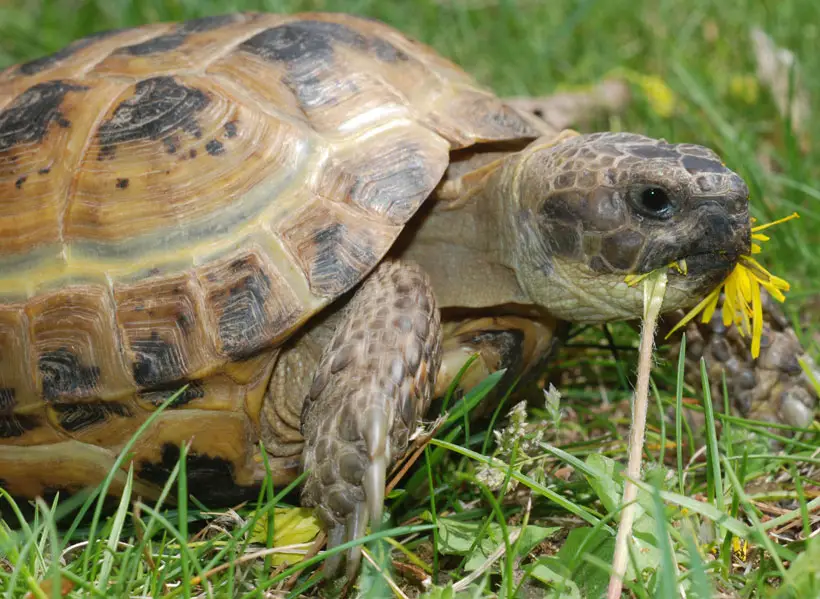
- Nature: Russian Tortoises are flexible and good at protecting themselves. They prefer high heights for living. Russian tortoises often burrow during winters and spend colder months in a dormant state.
- Lifespan: Russian tortoises live up to 40 years, which means you can probably have them by your side until old age.
- Whereabouts: Russian tortoises thrive in arid environments. And they remain inactive or slow in cold environments. Russia and Central Asia are home to Russian tortoises.
- Species Size: They are small reptile breeds that grow 8 to 10 inches when they enter maturity.
- Preferred environment: Russian tortoise is good at climbing; hence, you need to build a wall 1 foot high and bury it at least 6″ deep in the ground. A glass aquarium 5 feet wide is also suitable for them to live in.
- Required Temperature: During the daytime, their space should be between 85°F-88°F and 75°F-80°F temperature at night. The basking area temperature for Russian tortoises should be between 95°F-100°F.
- Diet: This best pet tortoise that stays small is vegetarian. Russian tortoises are mostly fed on grass, flowers, twigs, and fruits.
Medium Size Pet Tortoise Species
4. Yellow-Footed Tortoise (Chelonoidis Denticulata)
This is the best pet tortoise species for beginners which has fun nature and beautiful colors. Here are more details about this mid-size tortoise.
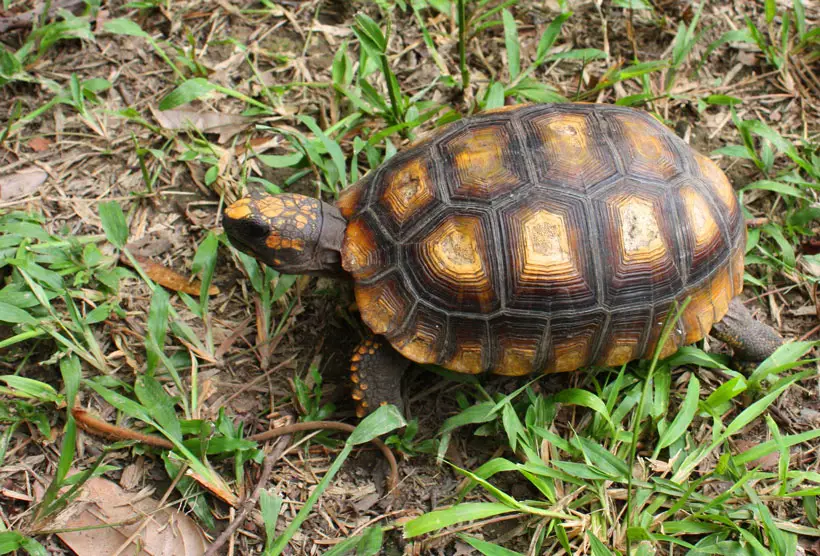
- Lifespan: Yellow-footed tortoises are known for their long lives. They can live up to 50 years.
- Whereabouts: This tortoise species is native to South America and can be found in rainforests. Besides, yellow-footed tortoises can also be found in Southeastern Venezuela, French Guiana, Eastern Colombia, Guyana, Ecuador, etc.
- Species Size: Male yellow-footed tortoises can grow up to 15 inches, and females grow between 24 to 30 inches. Some rare individuals of Yellow-footed tortoises can grow up to 37 inches.
- Preferred Surroundings: Yellow-footed tortoises don’t need a particular set-up in their home spaces. Just consider placing a substrate material on the floor to hold humidity.
- Required Temperature: They prefer an enclosure temperature between 70°F-80°F and a basking area of 85°F-90°F. However, the temperature shouldn’t be up to 90°F in the daytime and less than 65°F at night. You also need to ensure 80% humidity in their enclosure.
- Diet: These types of pet tortoise feed on fallen fruits, grass, leaves, and flowers. Yellow-footed tortoises also eat insects or carrion occasionally.
5. Elongated Tortoise (Indotestudo Elongata)
This tortoise species is a rewarding pet as long as you can ensure proper warmth and humidity for them throughout the year. However, they are categorized as an endangered species by Vietnamese law.
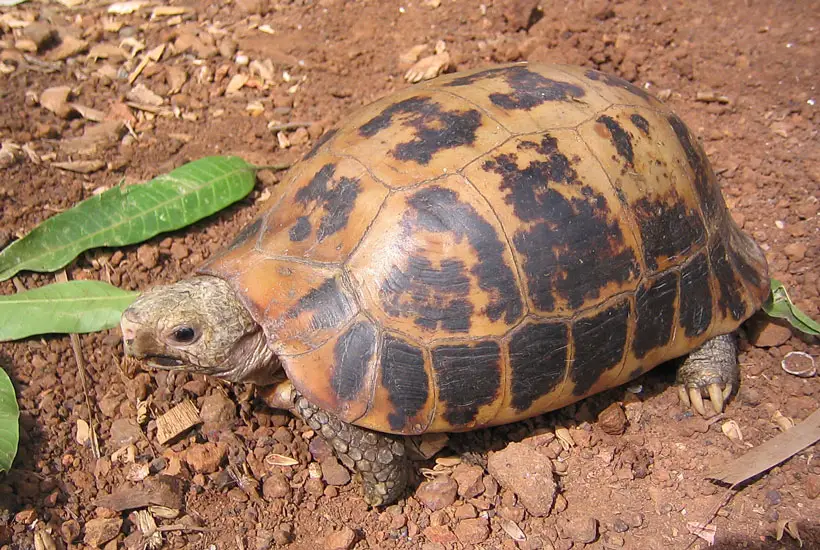
- Lifespan: An elongated tortoise can live from 40 to 50 years with proper care.
- Behavior: Elongated tortoises are calm and very friendly. They pass their day mostly by looking for food and resting.
- Whereabouts: They are native tortoises to Asia. Elongated tortoises can be found in Thailand, South China, Vietnam, Pakistan, Nepal, India, Bangladesh, Myanmar, Malaysia, and more.
- Species Size: As a mid-size tortoise species, the elongated tortoise can grow up to 12 to 14 inches.
- Preferred Surroundings: Their enclosure size should be at least 8 feet long and 6 feet spacious. Fill the floor with water-absorbent material, such as peat moss. Keep the soil moist, not overfilled with water. Plant some trees in their spaces.
- Required Temperature: During summer, their enclosure temperature should be 78°F to 86°F in the daytime. And they can handle 75°F temperature in winter. The temperature can fall to 65°F at night.
- Diet: Elongated tortoises feed on fruits and vegetables such as carrots, peas, apples, watermelon, zucchini, squash, flowers, sweet potatoes, etc.
6. Leopard Tortoise (Stigmochelys Pardalis)
This tortoise species is a native tortoise of Africa. However, the leopard tortoise is known as the fourth largest species worldwide. Due to their sizes, they are not suitable tortoise pets at home.
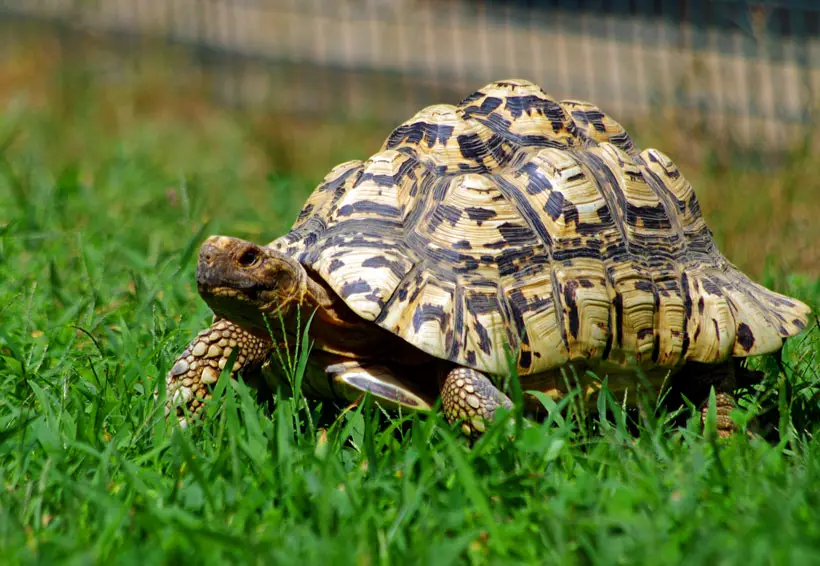
- Lifespan: Leopard tortoises can live for 100 years in normal conditions. However, they may live between 30 to 75 years in captivity.
- Behavior: They’re slow, docile, and spend their day mostly eating and resting.
- Whereabouts: Leopard Tortoises live in central and southern Africa. They prefer living in a dry place as they can’t tolerate moisture.
- Species Size: They may grow into different sizes depending on their varieties. Generally, adult leopard tortoises can grow from 10-18 inches. But the South African subspecies may grow up to 24″.
And varieties from Somalia and Ethiopia may grow up to 30″. Therefore, large Leopard tortoise varieties are often considered the large tortoise species.
- Preferred Surroundings: Due to their sizes, you can keep them as an outdoor pet tortoise. Make their outdoor home at least 80 to 90 square feet.
- Required Temperature: Their enclosure should be between 75°F-90°F and the basking space to 95°F. If the temperature falls below 70°F at night, provide them additional heat. Ensure sun exposure or UVB lights to help them absorb calcium.
- Diet: As a strict herbivore species, they feed on grass, forbs, succulents, berries, etc. They avoid green veggies.
Large Pet Tortoise Species
7. Sulcata Tortoise (Centrochelys Sulcata)
This is the largest pet tortoise species to raise at home. Although they are large, Sulcata tortoises are a great option to adopt as a pet.
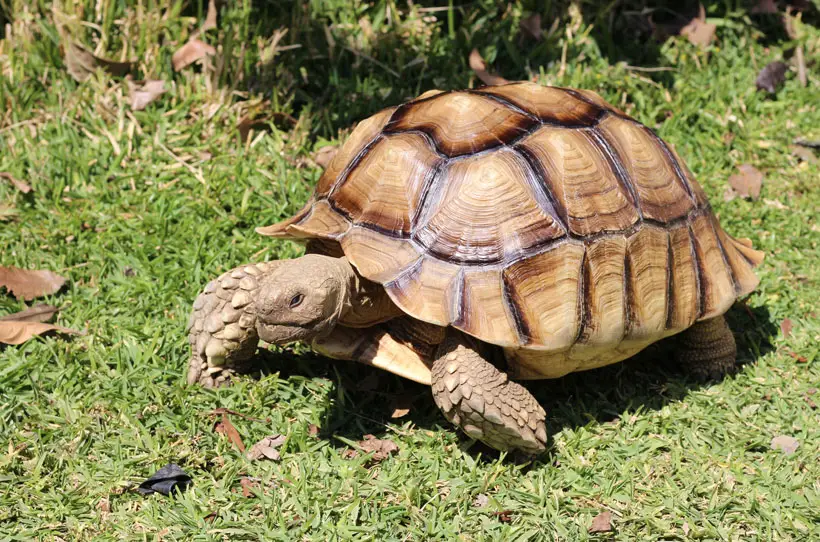
- Lifespan: Sulcata tortoises can live more than 70 years, meaning they can probably accompany you throughout your life.
- Behavior: These tortoises are intelligent, love interacting, and can easily adapt to new environments.
- Whereabouts: Sulcata tortoises are native to Northern Africa. They can be found in the Sahel and the Sahara Desert. It also indicates that they prefer living in semi-arid areas.
- Species Size: This tortoise species can grow up to 24 to 30 inches after reaching its mature age. However, research shows that a rare individual grew up to 41.6 inches.
- Preferred Surroundings: Sulcata tortoises are strong enough to knock down a simple wall easily. Consider building a sturdy fence at least 24 inches high from the ground.
- Required Temperature: They can withstand 85°F-105°F during the daytime. At night, the temperature can drop to 70°F. Additionally, they need 40% to 60% humidity in their enclosure.
- Diet: Sulcata tortoises enjoy feeding on kale, grape leaves, cactus pads, mulberry leaves, spring mixes, lawn grasses, etc.
FAQs
Let’s check out some more queries that people often ask themselves.
Yes, pet tortoises are friendly. But you have to earn this tortoise friendliness by ensuring a comfortable environment and healthy food.
Almost all tortoises cost over $170 to $200. But baby tortoises cost lower than this range. Adopt a baby tortoise and grow it with affection.
Search tortoise for sale on Google, and you should find some reliable sellers from whom you can adopt your pet tortoise.
Conclusion
So you now know the best pet tortoise species for beginners. Remember that some of these breeds are long-lived and may also meet your grandchildren. Hence, it’s necessary that you’re ready to provide them with proper care, comfort, food, and temperature as needed.
Besides these necessities, you also need to decorate their space accordingly. That’s why you should study their whereabouts. If the tortoise prefers a dry place, keep their space dry. Again keep some water pots in their space if they prefer living in a moist environment.

